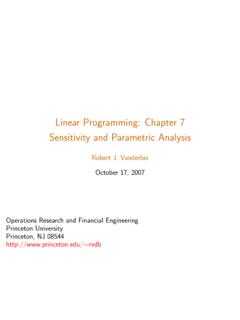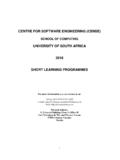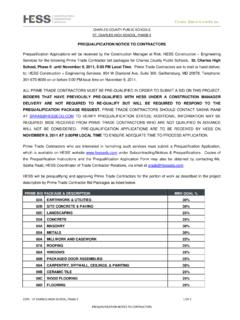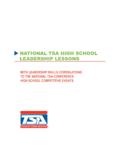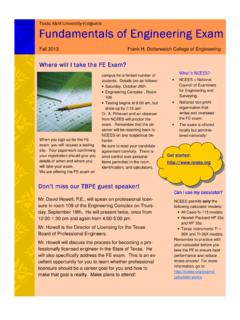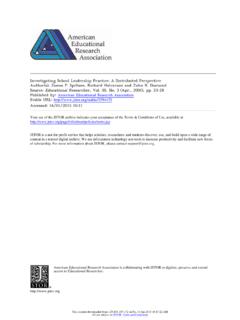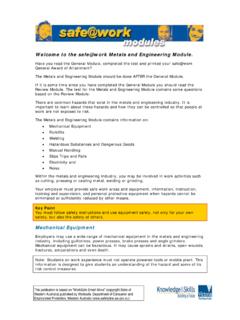Transcription of Mathematical Methods of Engineering Analysis
1 Mathematical Methods of Engineering AnalysisErhan C inlarRobert J. VanderbeiFebruary 2, 2000 ContentsSets and Functions11 Sets ..1 Subsets ..2 Set Operations ..2 Disjoint Sets ..3 Products of Sets ..32 Functions and Sequences ..4 Injections, Surjections, Bijections ..4 Sequences ..53 Countability ..64On the Real Line ..8 Positive and Negative ..9 Increasing, Decreasing ..9 Bounds ..9 Supremum and Infimum ..9 Limits ..10 Convergence of Sequences ..115 Series ..14 Ratio Test, Root Test ..16 Power Series ..17 Absolute Convergence ..18 Rearrangements ..19 Metric Spaces236 Euclidean Spaces ..23 Inner Product and Norm ..23 Euclidean Distance ..247 Metric Spaces ..25 Usage ..26 Distances from Points to Sets and from Sets to Sets ..26 Balls ..268 Open and Closed Sets.
2 29 Closed Sets ..30 Interior, Closure, and Boundary ..30iOpen Subsets of the Real Line ..319 Convergence ..34 Subsequences ..35 Convergence and Closed Sets ..3610 Completeness ..37 Cauchy Sequences ..37 Complete Metric Spaces ..3811 Compactness ..40 Compact Subspaces ..40 Cluster Points, Convergence, Completeness ..41 Compactness in Euclidean Spaces ..42 Functions on Metric Spaces4512 Continuous Mappings ..45 Continuity and Open Sets ..46 Continuity and Convergence ..46 Compositions ..47 Real-Valued Functions ..48Rn-Valued Functions ..4813 Compactness and Uniform Continuity ..50 Uniform Continuity ..5114 Sequences of Functions ..53 Cauchy Criterion ..54 Continuity of Limit Functions ..5615 Spaces of Continuous Functions ..57 Convergence inC..57 Lipschitz Continuous Functions.
3 58 Completeness ..60 Functionals ..60 Differential and Integral Equations6316 Contraction Mappings ..63 Fixed Point Theorem ..6417 Systems of Linear Equations ..69 Maximum Norm ..69 Manhattan Metric ..70 Euclidean Metric ..70 Conclusion ..7118 Integral Equations ..71 Fredholm Equation ..71 Volterra Equation ..76 Generalization of the Fixed Point Theorem ..7719 Differential Equations ..78iiConvex Analysis8320 Convex Sets and Convex Functions ..8321 Projection ..8622 Supporting Hyperplane Theorem ..90 Measure and Integration9123 Motivation ..9124 Algebras ..93 Monotone Class Theorem ..9425 Measurable Spaces and Functions ..96 Measurable Functions ..96 Borel Functions ..97 Compositions of Functions ..97 Numerical Functions ..97 Positive and Negative Parts of a Function.
4 98 Indicators and Simple Functions ..98 Approximations by Simple Functions ..99 Limits of Sequences of Functions .. 100 Monotone Classes of Functions .. 100 Notation .. 10126 Measures ..103 Arithmetic of Measures .. 104 Finite, -finite, -finite measures ..104 Specification of Measures .. 105 Image of Measure .. 106 Almost Everywhere .. 10627 Integration ..108 Definition of the Integral .. 109 Integral over a Set .. 110 Integrability .. 110 Elementary Properties .. 110 Monotone Convergence Theorem .. 111 Linearity of Integration .. 113 Fatou s Lemma .. 113 Dominated Convergence Theorem .. 114iiiSets and FunctionsThis introductory chapter is devoted to general notions regarding sets, functions, se-quences, and series. The aim is to introduce and review the basic notation, terminology,conventions, and elementary SetsAsetis a collection of some objects.
5 Given a set, the objects that form it are called itselements. Given a setA, we writex Ato mean thatxis an element ofA. To say thatx A, we also use phrases likexis inA,xis a member ofA,xbelongs toA, specify a set, one can either write down all its elements inside curly brackets (ifthis is feasible), or indicate the properties that distinguish its elements. For example,A={a, b, c}is the set whose elements area,b, andc, andB={x:x > }is theset of all numbers The following are some special sets: : Theempty set. It has no {1,2,3, ..}: Set ofnatural {0,1, 1,2, 2, ..}: Set +={0,1,2, ..}: Set ofpositive {mn:m Z, n N}: Set ( , ) ={x: < x <+ }: Set ofreals.[a, b] ={x R:a x b}:Closed intervals.(a, b) ={x R:a < x < b}:Open += [0, ) ={x R:x 0}: Set ofpositive AND FUNCTIONSS ubsetsA setAis said to be asubsetof a setBif every element ofAis an element ofB.]
6 WewriteA BorB Ato indicate it and use expressions likeAis contained inB,BcontainsA, to the same effect. The setsAandBare the same, and then we writeA=B, if and only ifA BandA B. We writeA6=BwhenAandBare not thesame. The setAis called aproper subsetofBifAis a subset ofBandAandBarenot the empty set is a subset of every set. This is a point of logic: letAbe a set;the claim is that A, that is, that every element of is also an element ofA,or equivalently, there is no element of that does not belong toA. But the last isobviously true simply because has no OperationsLetAandBbe sets. Theirunion, denoted byA B, is the set consisting of all elementsthat belong to eitherAorB(or both). Theirintersection, denoted byA B, is theset of all elements that belong to bothAandB. ThecomplementofAinB, denotedbyB\A, is the set of all elements ofBthat are not inA.
7 Sometimes, whenBisunderstood from context,B\Ais also called the complement ofAand is denoted byAc. Regarding these operations, the following hold:Commutative laws:A B=B A,A B=B laws:(A B) C=A (B C),(A B) C=A (B C).Distributive laws:A (B C) = (A B) (A C),A (B C) = (A B) (A C).The associative laws show thatA B CandA B Chave unambiguous of unions and intersections can be extended to arbitrary collections ofsets. LetIbe a set. For eachi I, letAibe a set. Theunionof the setsAi,i I, isthe setAsuch thatx Aif and only ifx Aifor someiinI. The following notationsare used to denote the union and intersection respectively: i IAi, i SETS3 WhenI=N={1,2,3, ..}, it is customary to write i=1Ai, i= of these notations follow the conventions for sums of numbers. For instance,n i=1Ai=A1 An,13 i=5Ai=A5 A6 A13stand, respectively, for the union overI={1.}
8 , n}and the intersection overI={5,6, .. ,13}.Disjoint SetsTwo sets are said to bedisjointif their intersection is empty; that is, if they have noelements in common. A collection{Ai:i I}of sets is said to bedisjointedifAiandAjare disjoint for alliandjinIwithi6= of SetsLetAandBbe sets. Theirproduct, denoted byA B, is the set of all pairs(x, y)withxinAandyinB. It is also called therectanglewith , .. , Anare sets, then their productA1 Anis the set of all n-tuples(x1, .. , xn)wherex1 A1, .. , xn An. This product is called, variously, a rect-angle, or a box, or an n-dimensional box. IfA1= =An=A, thenA1 Anis denoted byAn. Thus,R2is the plane,R3is the three-dimensional space,R2+is thepositive quadrant of the plane, LetEbe a set. Show the following for subsetsA, B, C, , all complements are with respect toE; for instance,Ac=E\ (Ac)c= \A=B Ac3.
9 (B\A) C= (B C)\(A C)4.(A B)c=Ac Bc5.(A B)c=Ac Bc6.( i IAi)c= i IAci7.( i IAi)c= i Letaandbbe real numbers witha < b. Find n=1[a+1n, b 1n], n=1[a 1n, b+1n]4 SETS AND Describe the following sets in words and {x R2:x21+x22<1} {x R2:x21+x22 1} \ LetAnbe the set of points(x, y) R2lying on the curvey= 1/xn,0< x < . What is n 1An?2 Functions and SequencesLetEandFbe sets. With each elementxofE, let there be associated a uniqueelementf(x)ofF. Thenfis called afunctionfromEintoF, andfis said tomapEintoF. We writef:E7 Fto indicate a function fromEintoF. ForxinE, the pointf(x)inFis called theimageofxor the value offatx. Similarly, forA E, the set{y F:y=f(x)for somex A}is called theimageofA. In particular, the image ofEis called therangeoff. Movingin the opposite direction, forB F,f 1(B) ={x E:f(x) B} called theinverse imageofBunderf.
10 Obviously, the inverse like mapping, operator, transformation are synonyms for the term function with varying shades of meaning depending on the context and on the setsEandF. Weshall become familiar with them in time. Sometimes, we writex7 f(x)to indicatethe mappingf; for instance, the mappingx7 x3+ 5fromRintoRis the functionf:R7 Rdefined byf(x) =x3+ , Surjections, BijectionsLetfbe a function fromEintoF. It is called aninjection, or is said to beinjective, oris said to beone-to-one, if distinct points have distinct images (that is, ifx6=yimpliesf(x)6=f(y)). It is called asurjection, or is said to besurjective, if its range isF,in which casefis said to be fromEontoF. It is called abijection, or is said to bebijective, if it is both injective and terms are relative toEandF. For examples,x7 exis an injection fromRintoR, but is a bijection fromRinto(0, ).

